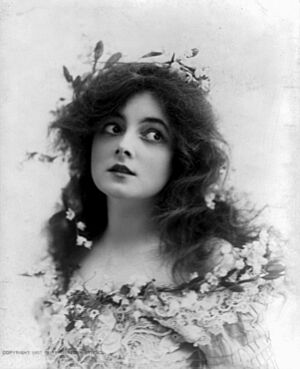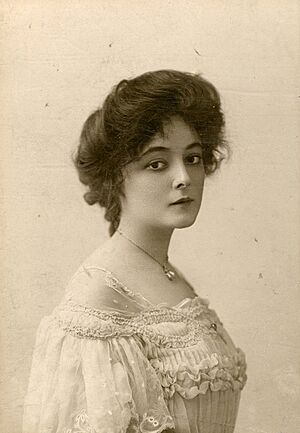Marie Doro facts for kids
Quick facts for kids
Marie Doro
|
|
|---|---|

Doro, c. 1902
|
|
| Born |
Marie Katherine Stewart
May 25, 1882 |
| Died | October 9, 1956 (aged 74) New York City, U.S.
|
| Spouse(s) |
Elliott Dexter
(m. 1915; div. 1922) |
Marie Doro (born Marie Katherine Stewart; May 25, 1882 – October 9, 1956) was an American actress. She was famous on stage and in early silent films.
Marie Doro was first noticed by a theater manager named Charles Frohman. He brought her to Broadway, where she also worked with William Gillette. Gillette was famous for playing "Sherlock Holmes." These two older mentors greatly shaped her early career. Even though she often played light, feminine roles, Marie was very smart and witty.
After Frohman died in 1915, she started making movies. She worked for film producer Adolph Zukor. Many of her early films are now lost. After making some movies in Europe, she returned to America. She became very interested in spiritual matters and lived a quiet life, avoiding friends.
In the early 1950s, author Daniel Blum wrote about her. He included her in his book Great Stars of the American Stage. This book celebrated many theater performers. Blum wrote a brief summary of her life and career. He also included photos from her time on Broadway. He even added a recent photo for fans who remembered her.
Contents
Marie Doro's Life and Career
Marie Katherine Stewart was born in Duncannon, Pennsylvania. Her birthday was May 25, 1882. Her parents were Richard Henry Stewart and Virginia Weaver.
She started her acting career in theater. She worked for manager Charles Frohman. In 1915, she began acting in movies. She signed a contract with film producer Adolph Zukor.
Marie was briefly married to actor Elliott Dexter. He was a vaudeville and silent film star. Their marriage ended in divorce. They did not have any children, and Marie never married again.
Her name was often linked to William Gillette. He was much older and famous for Sherlock Holmes. The press often connected him with his leading ladies. Marie and Gillette appeared in several plays together. These included The Admirable Crichton (1903) and Sherlock Holmes (1905–06). She also starred in his 1910 play Electricity.
While touring in England, she acted with a young Charlie Chaplin. He was a teenager at the time and admired her greatly. Years later, when he was famous, they met in America. Marie had to admit she didn't remember him.
A drama critic named William Winter described Marie Doro. He said she was "a young actress of charming beauty." He also noted her strong personality and expressive face.
Lowell Thomas, a famous traveler and writer, knew Marie well. He said her delicate beauty often led her to play sweet, simple roles. But offstage, she was very intelligent. She knew a lot about Shakespeare and old English poetry. She also had a sharp sense of humor.
She later said that two men greatly influenced her. These were Frohman and William Gillette.
Starting Out in Theater
Like many young women, Marie began in the chorus. She performed in musical comedy shows. In 1903, she had her first solo role in San Francisco. From there, she moved to New York. She appeared in plays like The Billionaire.
Charles Frohman noticed her talent. He believed she could become a star. He cast her as Lady Millicent in Little Mary in 1904. Later that year, she played Dora in Granny. This was a farewell tour for the legendary actress Mrs. G. H. Gilbert. Mrs. Gilbert died during the tour in Chicago.
The next year, Marie Doro played the main role in Friquet. She then went to London with William Collier Sr.'s company. After that, Frohman cast her in Clarice with Gillette. She played this role for two years.
Marie's career continued to grow. She appeared in plays like The Morals of Marcus and The Richest Girl. In 1910, she was in Gillette's Electricity. By 1912, she was a well-known actress. She joined a production of Oliver Twist. This was one of the first times this story was performed on stage. She also appeared in Patience with De Wolf Hopper. In 1914, she joined Gillette again in Diplomacy.
Moving to Silent Films
Marie Doro's stage career ended in 1915. This was when Charles Frohman died on the Lusitania ship. After this, she made eighteen motion pictures. She even appeared in one of the first 3-D films shown to a paying audience.
Her first film was The Morals of Marcus in 1915. This film is now lost. She had starred in the Broadway play it was based on. The next year, she played the lead in the 1916 film Oliver Twist. She had played this role successfully on stage before. Throughout the 1910s, Marie Doro was a very popular leading lady. Most of her early films are now lost. One of the few that still exists is Lost and Won from 1917.
By the early 1920s, Marie Doro became unhappy with Hollywood. She also grew tired of acting. She returned to Broadway one last time in 1921. She made two more films, with Sally Bishop being her last. In 1924, she left Hollywood. She moved to Europe for a while and made films in Italy and the UK.
After returning to the United States, she lived a very private life. She became deeply interested in spiritual matters. She moved to New York City and briefly studied at the Union Theological Seminary. She spent the rest of her life in seclusion. She often went on "retreats" to avoid friends. Sometimes she would even change hotels several times a week.
Later Life and Legacy
Marie Doro died in New York City in 1956. She was 74 years old and died of heart failure. In her will, she left $90,000 to the Actors' Fund. She was buried in Duncannon Cemetery in her hometown.
For her work in movies, Marie Doro received a star. It is on the Hollywood Walk of Fame at 1725 Vine Street in Hollywood, California.
Filmography
- The Morals of Marcus (1915) (Lost)
- The White Pearl (1915) (Lost)
- The Wood Nymph (1916) (Lost)
- Diplomacy (1916) (Lost)
- The Heart of Nora Flynn (1916) (Exists)
- Common Ground (1916) (Exists; British Film Institute)
- The Lash (1916) (Lost)
- Oliver Twist (1916) (Lost)
- Lost and Won (1917) (Exists; Library of Congress)
- Castles for Two (1917) (Exists; Library of Congress)
- Heart's Desire (1917) (Exists; Library of Congress)
- 12.10 (1919)
- A Sinless Sinner (1919) (Lost)
- The Mysterious Princess (1920) (Lost)
- Little Sister (1921) (Lost)
- The Stronger Passion (1921) (Lost)
- Sister Against Sister (1923) (Lost)
- Sally Bishop (1924) (Lost)
See also
 In Spanish: Marie Doro para niños
In Spanish: Marie Doro para niños




